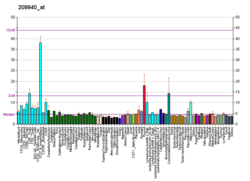PARP3
| PARP3 | |||||||||||||||||||||||||||||||||||||||||||||||||||
|---|---|---|---|---|---|---|---|---|---|---|---|---|---|---|---|---|---|---|---|---|---|---|---|---|---|---|---|---|---|---|---|---|---|---|---|---|---|---|---|---|---|---|---|---|---|---|---|---|---|---|---|
 | |||||||||||||||||||||||||||||||||||||||||||||||||||
| |||||||||||||||||||||||||||||||||||||||||||||||||||
| Identifiers | |||||||||||||||||||||||||||||||||||||||||||||||||||
| Aliases | PARP3, ADPRT3, ADPRTL2, ADPRTL3, ARTD3, IRT1, PADPRT-3, poly(ADP-ribose) polymerase family member 3 | ||||||||||||||||||||||||||||||||||||||||||||||||||
| External IDs | OMIM: 607726; MGI: 1891258; HomoloGene: 4005; GeneCards: PARP3; OMA:PARP3 - orthologs | ||||||||||||||||||||||||||||||||||||||||||||||||||
| |||||||||||||||||||||||||||||||||||||||||||||||||||
| |||||||||||||||||||||||||||||||||||||||||||||||||||
| |||||||||||||||||||||||||||||||||||||||||||||||||||
| |||||||||||||||||||||||||||||||||||||||||||||||||||
| |||||||||||||||||||||||||||||||||||||||||||||||||||
| Wikidata | |||||||||||||||||||||||||||||||||||||||||||||||||||
| |||||||||||||||||||||||||||||||||||||||||||||||||||
Poly [ADP-ribose] polymerase 3 is an enzyme that in humans is encoded by the PARP3 gene.[5][6]
The protein encoded by this gene belongs to the PARP family. These enzymes modify nuclear proteins by poly-ADP-ribosylation, which is required for DNA repair, regulation of apoptosis, and maintenance of genomic stability. This gene encodes the poly(ADP-ribosyl)transferase 3, which is preferentially localized to the daughter centriole throughout the cell cycle. Alternatively spliced transcript variants encoding different isoforms have been identified.[6]
References
- ^ a b c GRCh38: Ensembl release 89: ENSG00000041880 – Ensembl, May 2017
- ^ a b c GRCm38: Ensembl release 89: ENSMUSG00000023249 – Ensembl, May 2017
- ^ "Human PubMed Reference:". National Center for Biotechnology Information, U.S. National Library of Medicine.
- ^ "Mouse PubMed Reference:". National Center for Biotechnology Information, U.S. National Library of Medicine.
- ^ Johansson M (Aug 1999). "A human poly(ADP-ribose) polymerase gene family (ADPRTL): cDNA cloning of two novel poly(ADP-ribose) polymerase homologues". Genomics. 57 (3): 442–5. doi:10.1006/geno.1999.5799. PMID 10329013.
- ^ a b "Entrez Gene: PARP3 poly (ADP-ribose) polymerase family, member 3".
Further reading
- Bashford CL, Chance B, Lloyd D, Poole RK (1981). "Oscillations of redox states in synchronously dividing cultures of Acanthamoeba castellanii and Schizosaccharomyces pombe". Biophys. J. 29 (1): 1–11. Bibcode:1980BpJ....29....1B. doi:10.1016/S0006-3495(80)85114-9. PMC 1328658. PMID 7260241.
- Borggrefe T, Wabl M, Akhmedov AT, Jessberger R (1998). "A B-cell-specific DNA recombination complex". J. Biol. Chem. 273 (27): 17025–35. doi:10.1074/jbc.273.27.17025. PMID 9642267.
- Berghammer H, Ebner M, Marksteiner R, Auer B (1999). "pADPRT-2: a novel mammalian polymerizing(ADP-ribosyl)transferase gene related to truncated pADPRT homologues in plants and Caenorhabditis elegans". FEBS Lett. 449 (2–3): 259–63. doi:10.1016/S0014-5793(99)00448-2. PMID 10338144. S2CID 3251763.
- Still IH, Vince P, Cowell JK (2000). "Identification of a novel gene (ADPRTL1) encoding a potential Poly(ADP-ribosyl)transferase protein". Genomics. 62 (3): 533–6. doi:10.1006/geno.1999.6024. PMID 10644454.
- Dias Neto E, Correa RG, Verjovski-Almeida S, et al. (2000). "Shotgun sequencing of the human transcriptome with ORF expressed sequence tags". Proc. Natl. Acad. Sci. U.S.A. 97 (7): 3491–6. Bibcode:2000PNAS...97.3491D. doi:10.1073/pnas.97.7.3491. PMC 16267. PMID 10737800.
- Glowacki G, Braren R, Cetkovic-Cvrlje M, et al. (2001). "Structure, chromosomal localization, and expression of the gene for mouse ecto-mono(ADP-ribosyl)transferase ART5". Gene. 275 (2): 267–77. doi:10.1016/S0378-1119(01)00608-4. PMID 11587854.
- Wistow G, Bernstein SL, Wyatt MK, et al. (2002). "Expressed sequence tag analysis of human RPE/choroid for the NEIBank Project: over 6000 non-redundant transcripts, novel genes and splice variants". Mol. Vis. 8: 205–20. PMID 12107410.
- Strausberg RL, Feingold EA, Grouse LH, et al. (2003). "Generation and initial analysis of more than 15,000 full-length human and mouse cDNA sequences". Proc. Natl. Acad. Sci. U.S.A. 99 (26): 16899–903. Bibcode:2002PNAS...9916899M. doi:10.1073/pnas.242603899. PMC 139241. PMID 12477932.
- Augustin A, Spenlehauer C, Dumond H, et al. (2004). "PARP-3 localizes preferentially to the daughter centriole and interferes with the G1/S cell cycle progression". J. Cell Sci. 116 (Pt 8): 1551–62. doi:10.1242/jcs.00341. PMID 12640039.
- Gerhard DS, Wagner L, Feingold EA, et al. (2004). "The status, quality, and expansion of the NIH full-length cDNA project: the Mammalian Gene Collection (MGC)". Genome Res. 14 (10B): 2121–7. doi:10.1101/gr.2596504. PMC 528928. PMID 15489334.
- Rual JF, Venkatesan K, Hao T, et al. (2005). "Towards a proteome-scale map of the human protein-protein interaction network". Nature. 437 (7062): 1173–8. Bibcode:2005Natur.437.1173R. doi:10.1038/nature04209. PMID 16189514. S2CID 4427026.
- Rouleau M, McDonald D, Gagné P, et al. (2007). "PARP-3 associates with polycomb group bodies and with components of the DNA damage repair machinery". J. Cell. Biochem. 100 (2): 385–401. doi:10.1002/jcb.21051. PMID 16924674. S2CID 25618577.
- Ewing RM, Chu P, Elisma F, et al. (2007). "Large-scale mapping of human protein-protein interactions by mass spectrometry". Mol. Syst. Biol. 3 (1): 89. doi:10.1038/msb4100134. PMC 1847948. PMID 17353931.
- Lehtiö L, Jemth AS, Collins R, et al. (2009). "Structural basis for inhibitor specificity in human poly(ADP-ribose) polymerase-3". J. Med. Chem. 52 (9): 3108–3111. doi:10.1021/jm900052j. PMID 19354255.
External links
- PARP3 human gene location in the UCSC Genome Browser.
- PARP3 human gene details in the UCSC Genome Browser.
- v
- t
- e
 | This article on a gene on human chromosome 3 is a stub. You can help Wikipedia by expanding it. |
- v
- t
- e

















